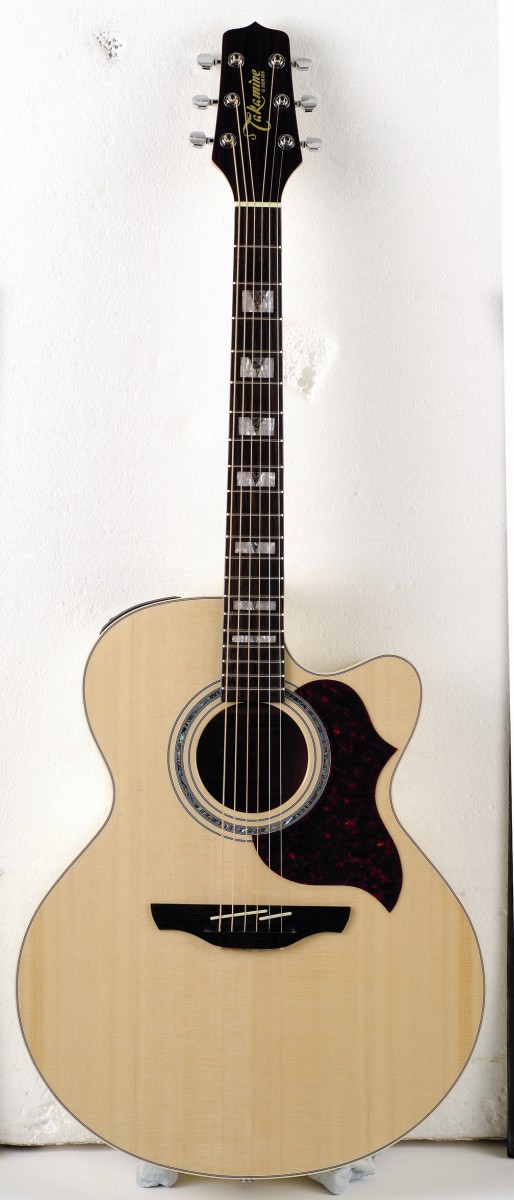MusicRadar Verdict
A great all rounder, combining warmth and body in a variety of tones.
Pros
- +
Tastefully glitzy looks. Warm sound for maple. Feature-packed preamp.
Cons
- -
Brittle top end when powered up.
MusicRadar's got your back
Developed by Gibson during the 1930s, the jumbo took the acoustic guitar to another level of largeness, aimed at delivering even more bottom-end muscle and cut-through.
It wasn't just cowboy crooners who took to the J-200 and its ilk for their larger-than-life appearance, but performers across a range of styles who wanted instruments better equipped to be heard acoustically in band situations.
Fast-forward to the present-day, and jumbos can be found in most manufacturers' line-ups, but the evolution of the design has gradually become more focused on cutaway electro variants.
Theoretically you'll still have the benefit of a powerful-sounding acoustic, but with the bonus of amplified performance to go with it.
Our review model represents a typical example of what's available between £300 and £500, a price bracket that's not only affordable but should also ensure decent long-term quality.
Overview
The EG523SC, one of Takamine's lower-cost models still being made in Korea following the recent move of part of the range to China, is a handsome study in blonde.
Behind the 16.7-inch-wide solid spruce front sit laminated maple back and sides, with flamed outer veneers edged in colour co-ordinating cream binding.
The neck is maple too, of a slightly darker shade and lacquered, like the body, to a high gloss.
Cosmetic detailing hits an appropriately showy note. The soundhole rosette carries a wide inlay ring of abalone, similar shell being used for the V inserts in the rosewood fingerboard's pearl block inlays.
The large tortie pickguard is another distinctive feature. Adopting Takamine's usual, fairly slim profile, the neck's depth is a little fuller than our other two guitars', but it maintains an almost constant depth, giving a comfortably accessible grip at all positions.
The fretting is very well dressed with smooth ends, and the board itself has a nicely oiled feel. Good also to see that string spacing at the bridge is wider than the Takamine norm - almost up to the regulation 55mm.
The EG's TK40 three-band preamp is an update of the old TK4N system, remodelled into a housing that conforms to Takamine's slot-in format.
An impressive feature array includes switchable mid contour and notch filter, and the onboard tuner - which responds promptly and accurately - is upgraded to a digital one with an LCD read-out.
The unit's only drawback, as with all similar Takamine preamps, is a very oblique view of the controls because of the shoulder mounting.
Sounds
Maple-backed acoustics, though invariably very well balanced across the strings, can often sound wiry and thin. Not this fella.
There's plenty of bright-edged beef to the delivery here, plus a surprising degree of sustaining warmth and richness in the low end.
It's largely good news when fired up too. Treble needs treating with discretion to avoid the top end sounding clacky and papery, but otherwise there's plenty of scope for fine-tuning some eminently decent sounds and all the necessary buttons, knobs and sliders to do it with.
Guitarist is the longest established UK guitar magazine, offering gear reviews, artist interviews, techniques lessons and loads more, in print, on tablet and on smartphones Digital: http://bit.ly/GuitaristiOS If you love guitars, you'll love Guitarist. Find us in print, on Newsstand for iPad, iPhone and other digital readers
“Sometimes I am two people. Johnny is the nice one. Cash causes all the trouble. They fight”: How Johnny Cash drew on his own experiences to make his greatest songs
“For those on the hunt for a great quality 12-string electro-acoustic that won’t break the bank, it's a no-brainer”: Martin X Series Remastered D-X2E Brazilian 12-String review
“I have that on more records than anything else”: Take a peek inside Vaughn Oliver’s studio











